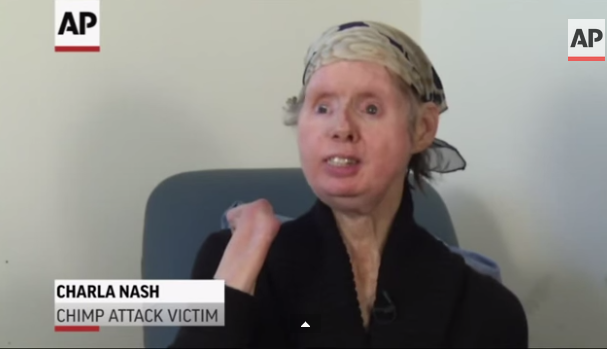Chimpanzee Attack Survivor Charla Nash's New Face May Forever Change Transplant Surgery

In February of 2009, Charla Nash survived an incredibly brutal chimpanzee attack. Unfortunately, she lost her hands, nose, eyes, lips, and mid-face bone structure, and received significant brain injuries at the hands of her neighbor’s 200-pound “pet.” The U.S. government quickly volunteered to step in and pay for Nash’s “unfathomable” medical bills, but what Nash may give the military doctors in return is truly priceless.
Due to the extent of her injuries, Nash became a candidate to become recipient of the novel complete face transplant, and in 2011 she received the innovative operation, fully funded by the U.S. government. The Pentagon’s involvement in Nash’s recovery did not end after surgery, however. Every six weeks Nash undergoes lab tests for the military, MRIs and CT scans, to determine how well her brain is sending signals to her new face, The Associated Press repored. The military doctors are also interested in how well Nash’s body is delivering blood to her new face and how her scars are healing.
Although the tests are in exchange for the free medical care, Nash, the daughter of a U.S. Air Force veteran, does not seem to mind. The 61-year-old explained that she’s happy to “do something good out of all this bad,” and potentially help wounded soldiers.
“They asked me, could they? I said, 'Yeah, I'd be thrilled to help out in any way I could,'" said Nash, AP reported.
The next biggest hurdle in Nash’s recovery is coming off of the immunosuppression medication. In all organ transplants the recipient’s body will reject the foreign body part. Immunosuppression drugs help to prevent this rejection and are given to the recipient for the rest of his life. Unfortunately, these drugs carry a high risk of serious health complications, including viral infections, kidney failure, and even cancer.
In a new treatment, Nash will be switched from her regular immunosuppressions to Interleukin-2, a drug commonly used to treat skin and kidney cancers. It’s hoped that the Interleukin-2 will promote the growth of new cells that will in turn protect her against transplant rejection. This would provide her with a resistance to rejection without the need for harsh medication.
If the Interleukin-2 drug proves to work on Nash, it would mean that transplants may become an even more common operation and could even be done on “non-vital” organs, such as fingers and ears, which are currently not viewed as worth the risk of rejection drugs.
The face and extremities are the most common wounds experienced by soldiers in war, and although Nash’s hand transplants had to be removed, her face is helping add to ongoing research on the relatively new operation.
AP reported that since the world’s first face transplant in 2005, 35 full or partial face transplants have been performed worldwide. Today it’s estimated that of the 560 soldiers who have suffered severe facial wounds in Iraq and Afghanistan, 50 to 60 of those may be viable candidates for the face transplant surgery. The Pentagon’s observations of Nash will go on to not only help the many U.S. wounded warriors, but also help to make advancements in transplant operations for all patients.
Published by Medicaldaily.com



























